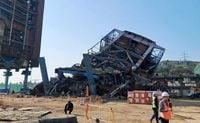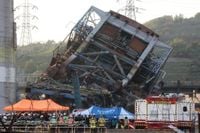On Thursday afternoon, November 6, 2025, the southeastern industrial city of Ulsan, South Korea, was rocked by a devastating accident when a 60-meter (196-foot) boiler tower collapsed at a decommissioned thermal power plant. The incident, which occurred around 2 p.m. local time, has left at least three people confirmed dead and two others presumed dead, with several more feared trapped beneath tons of twisted metal and debris. The collapse has cast a harsh spotlight on South Korea’s ongoing struggle with industrial safety, and prompted a massive emergency response from both local and national authorities.
The structure that failed was part of the Ulsan Thermal Power Plant, a facility that had been decommissioned in 2021 after 40 years of operation. According to officials cited by the Associated Press and Reuters, the boiler tower was one of three at the site and had been weakened as it was being prepared for demolition. Workers were in the process of taking down parts of the decommissioned heating facility, and explosives were reportedly being used to help dismantle the aging structure.
At the time of the accident, nine people were working at the site. Fire official Kim Jeong-shik told reporters that two workers were pulled to safety soon after the collapse, escaping life-threatening injuries. However, the situation quickly escalated in severity. “Five people remain trapped under the rubble, including two whom officials have yet to locate,” Kim said during a briefing, as reported by AP. Over the following hours, rescue workers managed to pull out another worker, but tragically, that individual was pronounced dead at a hospital early Friday. Another body was recovered later, and a doctor at the site confirmed the death of a third worker who had been among those trapped in the rubble. Fire officials believe the remaining two missing workers are also dead, though their bodies have not yet been recovered.
The rescue operation has been both massive and fraught with danger. More than 340 rescue workers and dozens of vehicles were deployed to the site, along with search dogs, thermal cameras, endoscopes, and other detection equipment. The scene, described by Yonhap News Agency and UPI, was one of chaos and urgency, with a massive steel structure toppled on its side and crumpled beams and scaffolding scattered at its base. Photos shared by local media captured the scale of the devastation.
But the rescue effort has been hampered by hazardous conditions. The site is covered with large amounts of asbestos and glass fibers, and the space is extremely cramped, forcing rescue workers to clear debris manually. Kim Jeong-shik explained, “The rescue site is currently covered with large amounts of asbestos and glass fibers … and the space is extremely cramped, forcing rescue workers to manually clear the debris by hand in order to carry out the rescue operations.” Even the vibrations from rescue equipment posed a risk of further collapse, complicating the already perilous task of reaching those still trapped. At one point on Friday morning, the search was temporarily halted due to concerns over unstable rubble, only resuming after stabilization work and after rescuers spotted additional workers within the debris.
The Ulsan Thermal Power Plant, operated by the state-run Korea East-West Power Co., has long been a fixture of the city’s industrial landscape. Built in 1973, the plant was part of a broader push to develop Ulsan into a manufacturing and industrial hub on South Korea’s southeast coast. The utility declined to comment on the accident, according to the New York Times.
As news of the collapse spread, South Korea’s top leadership responded swiftly. President Lee Jae Myung instructed officials to mobilize all available personnel and equipment for the rescue effort, while emphasizing the need to ensure the safety of rescue workers operating in such hazardous conditions. “When fatal accidents occur in the same way, it ultimately amounts to condoning these deaths,” Lee had said at a cabinet meeting in July, as quoted by UPI. Lee, who himself suffered a factory accident as a teenager, has made workplace safety a central issue of his administration. In August, he ordered that every workplace fatality be reported directly to his office and proposed sanctions such as revoking business licenses and restricting bids from companies with repeated deaths. Lee has pledged to reduce South Korea’s industrial accident mortality rate—the highest among the 38 Organization for Economic Co-operation and Development (OECD) member countries—to the OECD average within five years.
Prime Minister Kim Min-seok also issued orders to the Ministry of the Interior and Safety, National Fire Agency, Korean National Police Agency, and local authorities to “mobilize all available equipment and personnel to prioritize saving lives.” Interior Minister Yun Ho-jung echoed this directive, calling for mass mobilization and dispatching a situation-management officer to coordinate on-site operations. The government’s response, while swift, has not quieted criticism of South Korea’s industrial safety regime, which has come under renewed scrutiny in the wake of this and other recent workplace tragedies.
Industrial accidents have been a persistent problem in South Korea, with the country’s workplace fatality rate remaining stubbornly high despite repeated government pledges to improve safety standards. The collapse in Ulsan is only the latest in a series of fatal incidents that have put pressure on both regulators and companies to take more aggressive action. According to UPI, President Lee’s administration has faced calls for tougher enforcement, including revoking business licenses and imposing stricter penalties on companies with repeated workplace deaths.
For the families of the victims and the people of Ulsan, the tragedy is a stark reminder of the dangers faced by workers in heavy industry. The boiler tower, nearly 200 feet high and decommissioned for several years, was in the final stages of being dismantled when disaster struck. The fact that such a catastrophic accident occurred during a planned demolition—when safety protocols should be at their most rigorous—has only intensified calls for accountability and reform.
As of Friday afternoon, the search and rescue operation at the Ulsan power plant remained ongoing. Authorities continued to use every tool at their disposal, from thermal cameras to search dogs, in the hope of locating the remaining missing workers. But with each passing hour, hope for finding survivors has faded. The nation watches, waiting for answers and, perhaps, a renewed commitment to the safety of those who keep its industries running.
In the aftermath of the collapse, South Korea faces not only the immediate task of recovering the lost and supporting the bereaved, but also the longer-term challenge of ensuring that such tragedies are not repeated. The events in Ulsan serve as a somber call to action for a country striving to balance economic progress with the safety and dignity of its workers.






